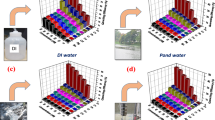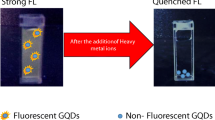Abstract
Highly sensitive methods are important for monitoring the concentration of metal ions in industrial wastewater. Here, we developed a new probe for the determination of metal ions by fluorescence quenching. The probe consists of hydroxylated graphene quantum dots (H-GQDs), prepared from GQDs by electrochemical method followed by surface hydroxylation. It is a non-reactive indicator with high sensitivity and detection limits of 0.01 μM for Cu2+, 0.005 μM for Al3+, 0.04 μM for Fe3+, and 0.02 μM for Cr3+. In addition, the low biotoxicity and excellent solubility of H-GQDs make them promising for application in wastewater metal ion detection.
Similar content being viewed by others
References
B. Li, Z.S. He, H.X. Zhou, H. Zhang, W. Li, T.Y. Cheng, and G.H. Liu, Reaction based colorimetric and fuorescence probes for selective detection of hydrazine, Dyes Pigm., 146(2017), p. 300.
J. Yao, M. Yang, and Y.X. Duan, Chemistry, biology, and medicine of fluorescent nanomaterials and related systems: newinsights into biosensing, bioimaging, genomics, dagnostics, and therapy, Chem. Rev., 114(2014), No. 12, p. 6130.
A.T. Aron, A.G. Reeves, and C.J. Chang, Activity-based sensing fluorescent probes for iron in biological systems, Curr. Opin. Chem. Biol, 43(2018), p. 113.
D.J. Cho and J.L. Sessler, Modern reaction-based indicator systems, Chem. Soc. Rev., 38(2009), No. 6, p. 1647.
P. Roy, P.C. Chen, A.P. Periasamy, Y.N. Chen, and H.T. Chang, Photoluminescent carbon nanodots: Synthesis, physicochemical properties and analytical applications, Mater. Today, 18(2014), No. 8, p. 447.
J. Wen, Y.Q. Xu, H.J. Li, A.P. Lu, and S.G. Sun, Recent applications of carbon nanomaterials in fluorescence biosensing and bioimaging, Chem. Commun., 51(2015), No. 57, p. 11346.
Y.B. Song, S.J. Zhu, and B. Yang, Bioimaging based on fluorescent carbon dots, RSC Adv., 4(2014), No. 52, p. 27184.
L.P. Lin, X.H. Song, YY. Chen, M.C. Rong, Y.R. Wang, L. Zhao, T.T. Zhao, and X. Chen, Europium-decorated graphene quantum dots as a fluorescent probe for label-free, rapid and sensitive detection of Cu2+ and l-cysteine, Anal. Chim. Acta, 891(2015), p. 261.
Y. Li, X.Q. Liu, Q.Y. Li, J. Ge, H. Liu, S. Li, L.F. Wang, J. Wang, and N. Ma, Post-oxidation treated graphene quantum dots as a fluorescent probe for sensitive detection of copper ions, Chem. Phys. Lett., 664(2016), p. 127.
X.C. Fu, J.Z. Jin, J. Wu, J.C. Jin, and CG. Xie, A novel “turn-on” fluorescence sensor for high selectively detecting Al (III) in aqueous solution based on simple electrochemical synthesized carbon dots, Anal Methods, 9(2017), No. 26, p. 3941.
KG. Qu, J.S. Wang, J.S. Ren, and XG. Qu, Carbon dots prepared by hydrothermal treatment of dopamine as an effective fluorescent sensing platform for the label-free detection of iron(III) ions and dopamine, Chem. Eur. J., 19(2013), No. 22, p. 7243.
B.J. Wang, S.J. Zhuo, L.Y. Chen, and Y.J. Zhang, Fluorescent graphene quantum dot nanoprobes for the sensitive and selective detection of mercury ions, Spectrochim. Acta Part A, 131(2014), p. 384.
S. Sharma, A. Umar, S.K. Mehta, and S.K. Kansal, Fluorescent spongy carbon nanoglobules derived from pineapple juice: A potential sensing probe for specific and selective detection of chromium (VI) ions, Ceram. Int., 43(2017), No. 9, p. 7011.
FX. Wang, ZY. Gu, W. Lei, W.J. Wang, X.F. Xia, and Q.L. Hao, Graphene quantum dots as a fluorescent sensing platform for highly efficient detection of copper(II) ions, Sens. Actuators B, 190(2014), p. 516.
X.F. Niu, Y.B. Zhong, R. Chen, F. Wang, Y.J. Liu, and D. Luo, A “turn-on” fluorescence sensor for Pb2+ detection based on graphene quantum dots and gold nanoparticles, Sens. Actuators B, 255(2018), p. 1577.
S.H. Zhou, H.B. Xu, W. Gan, and Q.H. Yuan, Graphene quantum dots: Recent progress in preparation and fluorescence sensing applications, RSC Adv., 6(2016), No. 112, p. 110775.
S.J. Zhu, J.H. Zhang, C.Y. Qiao, S.J. Tang, Y.F. Li, W.J. Yuan, B. Li, L. Tian, F. Liu, R. Hu, H.N. Gao, H.T. Wei, H. Zhang, H.C. Sun, and B. Yang, Strongly green-photolu-minescent graphene quantum dots for bioimaging applications, Chem. Commun., 47(2011), No. 24, p. 6858.
Y.Q. Feng, J.P. Zhao, X.B. Yan, F.L. Tang, and Q.J. Xue, Enhancement in the fluorescence of graphene quantum dots by hydrazine hydrate reduction, Carbon, 66(2014), No. 1, p. 334.
Z.S. Qian, XY. Shan, L.J. Chai, J.R. Chen, and H. Feng, A fluorescent nanosensor based on graphene quantum dots-aptamer probe and graphene oxide platform for detection of lead (II) ion, Biosens. Bioelectron., 68(2015), p. 225.
Y. Li, X.Q. Liu, J. Wang, H. Liu, S. Li, Y.B. Hou, W. Wan, W.D. Xue, N. Ma, and J.Z. Zhang, Chemical nature of redox-controlled photoluminescence of graphene quantum dots by post-synthesis treatment, J. Phys. Chem. C, 120(2016), No. 45, p. 26004.
Y. Li, H. Liu, X.Q. Liu, S. Li, L.F. Wang, N. Ma, and D.L. Qiu, Free-radical-assisted rapid synthesis of graphene quantum dots and their oxidizability studies, Langmur, 32(2016), No. 34, p. 8641.
P.H. Luo, Y. Qiu, X.F. Guan, and L.Q. Jiang, Regulation of photoluminescence properties of graphene quantum dots via hydrothermal treatment, Phys. Chem. Chem. Phys., 16(2014), No. 35, p. 19011.
S.J. Zhu, J.H. Zhang, S.J. Tang, CY. Qiao, L. Wang, HY. Wang, X. Liu, B. Li, Y.F. Li, W.L. Yu, X.F. Wang, H.C. Sun, and B. Yang, Surface chemistry routes to modulate the photoluminescence of graphene quantum dots: From fluorescence mechanism to up-conversion bioimaging applications, Adv. Funct. Mater., 22(2012), No. 22, p. 4732.
L.L. Li, G.H. Wu, G.H. Yang, J. Peng, J.W. Zhao, and J.J. Zhu, Focusing on luminescent graphene quantum dots: Current status and future perspectives, Nanoscale, 10(2013), No. 5, p. 4015.
S.L. Hu, A. Trinchi, P. Atkin, and I. Cole, Tunable photolu-minescence across the entire visible spectrum from carbon dots excited by white light, Angew. Chem. Int. Ed, 54(2015), No. 10, p. 2970.
T.J. Fan, W.J. Zeng, W. Tang, C.Q. Yuan, S.Z. Tong, KY. Cai, Y.D. Liu, W. Huang, Y. Min, and A.J. Epstein, Controllable size-selective method to prepare graphene quantum dots from graphene oxide, Nanoscale Res. Lett, 10(2015), No. 19, p. 55.
J.R. Lakowicz, Principles of Fluorescence Spectroscopy, 3rd Ed., Springer Science+Business Media, LLC, New York, 2006.
C.Q. Zhang, Y. Yan, Q.H. Pan, L.B. Sun, H.M. He, Y.L. Liu, Z.Q. Liang, and JY. Li, A microporous lanthanum metal-organic framework as a bi-functional chemosensor for the detection of picric acid and Fe3+ ions, Dalton Trans., 44(2015), No. 29, p. 13340.
X.H. Zhou, L. Li, H.H. Li, A. Li, T. Yang, and W. Huang, A flexible Eu(III)-based metal-organic framework: Turn-offluminescent sensor for the detection of Fe(III) and picric acid, Dalton Trans., 42(2013), No. 34, p. 12403.
X.Q. Dong, C.L. Li, J. Li, W.T. Huang, J. Wang, and R.B. Liao, Application of a system dynamics approach for assessment of the impact of regulations on cleaner production in the electroplating industry in China, J. Cleaner Prod, 20(2012), No. 1, p. 72.
L. Shi, J.S. Shi, and Y. Shi, Discussion on the emission standard of pollutants for electroplating, Electroplat. Finish., 28(2009), No. 5, p. 44.
C. Shen, SY. Ge, YY. Pang, F.N. Xi, J.Y. Liu, X.P. Dong, and P. Chen, Facile and scalable preparation of highly luminescent N,S co-doped graphene quantum dots and their application for parallel detection of multiple metal ions, J. Mater. Chem. B, 5(2017), No. 32, p. 6593.
X.F. Liu, W. Gao, X.M. Zhou, and YY. Ma, Pristine graphene quantum dots for detection of copper ions, J. Mater. Res., 29(2014), No. 13, p. 1401.
V. Dujols, F. Ford, and AW. Czarnik, A long-wavelength fluorescent chemodosimeter selective for Cu(II) ion in water, J. Am. Chem. Soc, 119(1997), No. 31, p. 7386.
L. F an, J.C. Qin, T.R. Li, B.D. Wang, and ZY. Yang, A novel rhodamine chromone-based “Off-On” chemo sensor for the differential detection of Al(III) and Zn(II) in aqueous solutions, Sens. Actuators B, 203(2014), No. 14, p. 550.
D. Wang, L. Wang, XY. Dong, Z. Shi, and J. Jin, Chemically tailoring graphene oxides into fluorescent nanosheets for Fe3+ ion detection, Carbon, 50(2012), No. 6, p. 2147.
J. Ju and W. Chen, Synthesis of highly fluorescent nitrogen-doped graphene quantum dots for sensitive, label-free detection of Fe (III) in aqueous media, Biosens. Bioelectron., 58(2014), p. 219.
C. Yi, WW. Tian, B. Song, Y.P. Zheng, Z.J. Qi, Q. Qi, and Y.M. Sun, A new turn-offfluorescent chemosensor for iron (III) based on new diphenylfluorenes with phosphonic acid, J. Lumin., 141(2013), p. 15.
L.Q Liu, Y.F Li, L. Zhan, Y. Liu, and C.Z. Huang, One-step synthesis of fluorescent hydroxyls-coated carbon dots with hydrothermal reaction and its application to optical sensing of metal ions, Sci. China Chem., 54(2011), No. 8, p. 1342.
Y.F. Chen, C.L. Kao, P.C. Huang, CY. Hsu, and C.H. Kuei, Facile synthesis of multi-responsive functional graphene quantum dots for sensing metal cations, RSC Adv., 6(2016), No. 105, p. 103006.
J.W. Xin, L.J. Mao, SG. Chen, and A.G. Wu, Colorimetric detection of Cr3+ using tripolyphosphate modified gold nanoparticles in aqueous solutions, Anal. Methods, 4(2012), No. 5, p. 1259.
H. Huang, Y.H. Weng, L.H. Zheng, BX. Yao, W. Weng, and X.C. Lin, Nitrogen-doped carbon quantum dots as fluorescent probe for “off-on” detection of mercury ions, L-cysteine and iodide ions, J. Colloid Interface Sci, 506(2017), p. 373.
Acknowledgements
This work was financially supported by the National Natural Science Foundation of China (No. 21674011) and Beijing Municipal Natural Science Foundation (No. 2172040).
Author information
Authors and Affiliations
Corresponding author
Rights and permissions
About this article
Cite this article
Ge, Q., Kong, Wh., Liu, Xq. et al. Hydroxylated graphene quantum dots as fluorescent probes for sensitive detection of metal ions. Int J Miner Metall Mater 27, 91–99 (2020). https://doi.org/10.1007/s12613-019-1908-4
Received:
Revised:
Accepted:
Published:
Issue Date:
DOI: https://doi.org/10.1007/s12613-019-1908-4




